The GYROTONIC® Method and Neuroplasticity
Blog Content // November 03, 2023
Many thanks to GYROTONIC® and GYROKINESIS® Master Trainer Angela Crowley, who wrote this article and gave her permission for us to share.
Introduction
Neuroplasticity is an exciting, quickly expanding, and respected field of science and medicine, providing vast new applications to us as somatic therapists. The GYROTONIC EXPANSION SYSTEM® is uniquely conducive to positive neuroplastic change in both its methodology and innovative equipment.
In this blog, I will describe the fundamental properties of neuroplasticity, ways in which movement can influence those properties for better or worse, and why the Gyrotonic Method partners so harmonically with creating positive neuroplastic change.
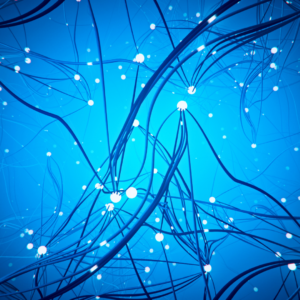
Photo provided by Angela Crowley
Understanding Neuroplasticity
Neuroplasticity is the ability of the brain to change its structure and its function throughout life according to what we do. We are constantly influencing positive or negative changes in our brains and in our lives as we go along. Until very recently, scientists thought of our brains more mechanistically like the hard drive of a computer.
We now know that the brain is constantly responding and adapting in both its structure and its function throughout our entire lives.
Before studying the Gyrotonic Method, I became a Guild Certified Feldenkrais Practitioner®. The Feldenkrais Method is a somatic approach to improve the organization of oneself, creating more efficiency, ease, and fulfillment in movement and in life. The creator of the system Moshe Feldenkrais, a physicist, is now recognized by leading scientists as a pioneer in the world of Neuroplasticity. His work and life preceded scientific research in neuroplasticity by about 60 years.
After I became a Feldenkrais practitioner, I found myself at odds with integrating this new knowledge into my Pilates practice. I began searching for an exercise training venue in which the fundamental principles of organic learning and full-body movement could be expressed. This is the point at which I discovered the Gyrotonic Expansion System.
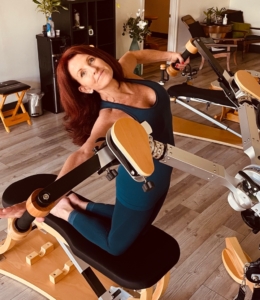
Photo provided by Angela Crowley
Now, with current science exposing the principles of Neuroplasticity, I humbly recognize in much greater depth the design of the Gyrotonic Method as a potent tool for neuroplastic change. The creator, Juliu Horvath, clearly understood throughout the genesis of his creations that the organic roots of movement and health are far deeper than the musculoskeletal system.
Nowhere is this truth better reflected than in the sense of well-being felt after a Gyrotonic session. This shift is often difficult to describe in words as it is an experience. Sometimes words are used like “feeling lighter, feeling more grounded or feeling freer.” Sometimes, it’s expressed as a more spiritual sensation of well-being. I believe the only way to define it scientifically is through a pervasive neuroplastic shift.
Key Requirements for Neuroplastic Change
Let’s start with the basics. The nervous system is based on messaging and mapping. The messages are relayed through the neurons to the brain, where they are mapped. Though there are topographical similarities in the structure and function of all human brains, the maps of each individual are as unique as their fingerprints. Just as each experience of our individual lives has been unique, so has the corresponding mapping of our brains. The Gyrotonic equipment is designed to adapt to the individuality of each person.
It used to be thought that once we reached a certain age, our learning had peaked. It was expected that as we age, we would diminish in our abilities to learn and function. What we now understand is that learning is possible throughout one’s entire life. It’s not that our brains lose the ability to learn. It is more a reflection of our tendency to stop learning as we become acceptably skilled or resign ourselves to aging. Just like our muscles, our brains have a use it or lose it component. To the extent they are positively engaged, new circuits are accessible. And even if one aspect of the brain is damaged or never developed, it is possible for other areas of the brain to take over the function. The flexibility and adaptability for us to learn, change and develop new brain maps throughout our lives is a characteristic of neuroplasticity.
It is important to understand that the neuroplasticity of our brains can be driven toward both positive and negative outcomes according to what we experience, do, think, feel and even imagine. Activities that are repeated most often become the strongest and fastest maps of the brain. They become habits which we can rely on to help us remember how to ride a bicycle, for example. Or they can become negative, such as postural habits from computer use. They can also become disorganized and very challenging in instances such as chronic pain and anxiety.
The opportunity is that wherever we find ourselves in life, we can trust that our brain is structured to be able to help us change, learn, heal, and grow with greater potential than we ever realized before.
The Gyrotonic Method and the Role in Positive Neuroplastic Change
So what does this have to do with The Gyrotonic Expansion System and movement? Movement is life. So, from the moment there is life, signaling is occurring in the nervous system that creates maps which help us develop, learn, and adapt. Since movement, especially the most essential movements like breathing, are occurring concurrently with every moment in life, movement maps become associated between the activities that happen concurrently, such as breath and experience. Usually, many centers of the brain are firing concurrently, which means they light up or fire together and are mapped together. As an example, think of the most basic skills an infant learns. Sensations like touch, desire, vision and hearing are all coordinated with multiple centers of our brains to help us survive, communicate, play, learn and become autonomous.
Not only are these movement maps generated by the developmental experiences of our life; they are internally known at the most primal level of ourselves based on the evolution of our species. The most essential skills for survival are innate or reflexive versus learned. They go back beyond our experiences as primates, further back, when we mobilized ourselves through the water with rhythmic undulating movements.
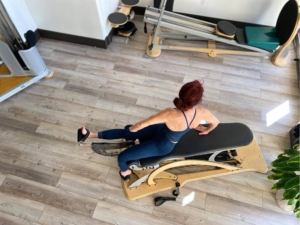
Photo provided by Angela Crowley
The wave is one of the most quintessential movements in the entire Gyrotonic exercise sequences. Often, people comment that the equipment gives them the sense of fluidity, like moving in water.
Our deepest primal wisdom is far more intelligent, reliable and efficient than cognition. Breath is an obvious example of contacting that primal intelligence for survival. Therefore, breath is not only reflective of these centers. Using breath, we can connect into the deepest centers of our organization and positively reset. Somewhat like restarting the computer, sometimes this reset leads to more superficial challenges and tensions to readily diminish.
Just as movement innately is connected to the maps of our history, so can we use movement to navigate our well-being in the present moment and the future.
In the Gyrotonic Method, from the awakening of the senses, the internal figure eights, the breathing patterns, eye movements and undulations of the body all tap us into our primal resources that we can rely on to help us access and improve the organization of ourselves and our well-being.
To create new mapping to maximize our potential through positive neuroplastic change, there are key requirements which are inherently a part of Gyrotonic sequences.
In the Gyrotonic Method, Juliu has created a myriad of options for shifting our attention from the outer world of multitasking into internal sensation. We do this through awakening the senses, scrubbing, internal figure eights and breath. Visualization and sensation are among the nervous system’s best tools to develop new brain maps to help release us from restrictions into possibilities.
Breathing changes with our activities. It is different when we sleep, laugh, cry, run or are stressed. And when our breath is held, the brain receives a message that we are not safe, and the tonus goes up through our entire selves, wasting energy in the form of tension. The Gyrotonic Method offers an unusual number of variations to our breathing patterns. Each of these variations diversifies the maps of our breathing in the brain and, thereby, the associations. This diversification of maps is key to unlocking deeply held unwanted patterns and provides the opening of new options that travel with us outside the session as well.
“Movement creates Breath (energy and life)
Breath (energy and life) creates Movement” Juliu Horvath
The Role of Attention in Neuroplastic Change
Without attention, our brain and nervous systems aren’t interested. So, they are not stimulated to continue to generate vital new mapping in our brain. The vast variations of movement patterns in the Gyrotonic Method multiplied by the different pieces of equipment and relationships with gravity require attention. (For an example, Gyrotonic Trainers can open this link or this link in your Trainer Resource Library.)
Redundant exercises of any form, though they may have some health benefits, are meek in their results if the person exercising is not engaged. The brain doesn’t have to pay attention. It is like putting our most valuable asset to sleep instead of revitalizing it. Walking on a treadmill redundantly distracting oneself by talking on the phone or watching TV will actually negatively impact brain health by creating a “noise” in the brain versus clarity and efficiency. Noise in the brain deteriorates brain health.
So, attention is a key requisite of positive neuroplastic change. And learning has been proven to amplify positive neuroplastic change. While learning a new task, it excites the neural pathways with curiosity and strengthens the mapping of those new patterns. Those of us who have practiced the Gyrotonic Expansion System throughout most of our lives continue learning every time we enter a session.
Energy, Melody, and Movement
Music is primal in nature, in every indigenous culture and in us. Beginning in the first Gyrotonic session, the approach to all movements are taught in a rhythmical and melodic way. Music reaches into our souls as well as our cells, our nerve cells, nervous system and brain. We first respond to our mother’s heartbeat and then lullabies. The soothing sound of the ocean resonates deeply in us. Gyrotonic exercises vary in tempos to calm, energize, and release excess tensions. In the Gyrotonic Method, the rhythm, the melody, and the sound of our own breath as music through fluid movements harmonize us.
“The body is like a musical instrument.” Juliu Horvath
“Every disease is a musical problem. Every cure, a musical solution.” Novalis German philosopher late 1700s, quoted by Neurologist Oliver Sacks, M.D.
Neural connections rely on energy to fire. The energy organizes the patterns as waves that generate coordinated function.
Karl Lashly, a pioneer in neuroscience before the term existed, said it like this, “ the learning and skills are encoded not ”in” specific neurons, or even “in” connections between neurons, but “in” the cumulative electrical wave patterns that are the result of the neurons firing together.”
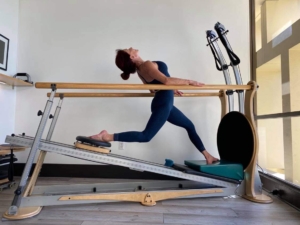
Angela Crowley on the Jumping-Stretching Board. Photo provided by Angela Crowley.
Norman Doidge MD, author of The Brain That Heals Itself, “To use an analogy, the patterns are like a musical piece, and the neurons are the orchestral musicians that play the piece.”
When patterns are disorganized, they create a “noisy brain” responsible for an array of dysfunctions. Energy such as light, especially sunlight, can positively influence health in the brain and body. For thousands of years, Chinese medicine has influenced the flow of energy to improve health.
Juliu Horvath hypothesizes that “the energetic blueprint that we all have innately determines how the body materializes. “ His presumption is based on his experience without scientific evidence.
From my viewpoint, it is his innate understanding of this integration of energy, melody, and fluid movement that feeds the brain with rebalancing harmony and vitality.
Figure Eights and Their Significance
The symbol of infinity, the figure eight, has a representation through all time that is considered sacred and harmonizing. It is not simply ethereal. It is present in mathematics and architecture. It is universally recognized within us, too. In systems of traditional healing, the sign of infinity is used to direct healing. In the Gyrotonic Expansion System, the internal figure eights are directed intentionally to bring energy through each chakra. The Gyrotonic and Gyrokinesis Methods expand into figure eights with the handles, figure eights in the hamstrings series, and walking in figure 8 ́s. I have always experienced visualizing a figure eight around my eyes, nurturing the optic nerves as my favorite.
Consider how many millions of years of eye movements have been part of us as a species. In Gyrotonic sessions, we learn to use our eyes to guide our movements again. Fixation of eye movement due to our culture of progressively narrowing our focus narrows our neck and spinal movements and progressively our perspective. Our visual focus is the way we as infants learned to orient ourselves in the world. Survival has historically required navigating the world around us, not just our computer screens in front of us. Relearning to connect our eyes to our movements expands, enlivens and quiets the optic nerves, having an immediate resonance in our nervous systems, expanding our potential, informing our balance, and expanding ourselves into the surrounding world.
“Let your eyes guide the direction of the movement, and by doing so consciously, the spine and the nervous system is fully engaged.” Juliu Horvath
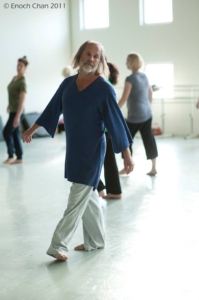
Juliu Horvath, Founder and Creator of The GYROTONIC® Method, walking in figure eights.
As we move through the system, we are increasingly learning to feel, think, sense, and act concurrently. As we progress, we become increasingly efficient. The movements cannot be done fluidly or rhythmically when the muscles are overworking. So, we also learn to release unnecessary efforts in our bodies, freeing our energy for clarity of the mind and enjoyment. This skill, as it is carried outside the studio, is invaluable. Stress shuts down learning. Pleasure and comfort attract the nervous system which is designed to care for us.
“Move within the comfort zone of the body, move with effortless effort and a smile in your heart.” Juliu Horvath
The Adaptability of the Gyrotonic Expansion System
The adaptability of both methods of the Gyrotonic Expansion System allows us to adapt to the needs of fluctuations in our nervous systems and those of our clients. As I have been recovering from a brain injury myself, it was essential that the movements initially did not challenge my brain but rather allowed me to move in ways that soothed my sensitivity.
A highly intellectual professional who has too much attention and tension in the mind, though a sense of a tired body, can be given challenging movements that require the body to wake up, releasing the tension in the mind and awakening the energy in the rest of the self. An elite athlete needs both. Their bodies are often overworked in specific ways, and the minds are fixated on achievement, which needs to be released to allow new, more efficient patterns to emerge. The creator of the system, Juliu Horvath, often plays games with professional dancers as a means to break that pattern and overcome fixation.
While playing, our brains generate 11 million instructions per second. Playing creates subconscious brain activity for the big picture and simultaneous responsiveness. Whereas when we use cognition, there are only 40 instructions happening per second, and they occur in a sequential versus global way. Here is an example: Often in exercise classes, a student is told to contract their abdominals to support their back. They will thereby try to train their abdominals through cognitive control. When landing from a ski jump or falling down, we need the abdominals to spontaneously respond to support our backs. Dr Carolyn Richardson’s research from Australia shows that deep core support activity does not respond to cognition. It responds to load and environment. In the Gyrotonic Method, abdominal activity is not isolated. It is a coordinated dynamically adjusting part of movements that occur in hundreds of variations of position, speed and relationship with gravity thus preparing their activity for surprises.
As Juliu says, “ A person slips on a banana peel or on ice and needs to “wiggle out of it” to regain balance instead of falling down.”
It is important that when one level of achievement is accomplished, the nervous system is perturbed with just the right amount of additional challenge so that the reward neuroreceptors essential to learning are not overwhelmed by too much complexity; yet the complexity must be increased enough to keep the growing appetite of the brain excited. The Gyrotonic methodology allows us to create a comforting environment when appropriate. Then, to strengthen the skills, we are able to adapt the amount of chaos/challenge for the individual at the appropriate rate. We can create variations that challenge multiple skills like balance, visual perception, and accuracy in moving through space at different tempos in varying relationships with gravity. The more ways a skill is learned and challenged, the stronger and more reliable the neural connections and maps become in our brains. The Gyrotonic Expansion System and equipment allow us to titrate workouts up or down as appropriate for the individual at that moment.
The Artistry of Teaching
The plasticity of the brain is equally available for negative neuroplastic change as it is for positive. The flexibility of neuroplasticity can equally strengthen bad habits and unwanted patterns such as addictions and chronic pain. It is therefore important to remember that the Gyrotonic Method if disrespected in its principles of approach, can create negative neuroplastic change just as easily as any inappropriately used gym or other activity. If Gyrotonic sessions are approached with an aggressive achievement orientation, using too much weight, done redundantly without attention, or randomly organized, the results can negatively affect the brain, the body, and the well-being of anyone. This is where the key to success is in the hands of the artistry of the teacher. And this artistry can only be understood through personal practice.
“Theory does not create experience. Experience creates theories. Without mindful practice, there is no experience.” Juliu Horvath
As I write this article, Juliu’s words echo in my thoughts.
At the end of a Gyrotonic session, when students say they feel taller, or freer, or more grounded, this positive shift in sensation is a reward which amplifies the release of more positive neurotransmitters that scientifically anchor the learning and allows us to reenter the world with a fresh perspective.
Feeling like we have come back home to ourselves…..because we have.
_________________________________________________
Take a look at other articles featuring Angela Crowley:
Complementing Your Pilates Practice with The GYROTONIC® Method
The GYROTONIC® Interview Series: With Professional Diver, Melanie Rinaldi
Specialized Course Highlight: GYROTONIC® Applications for High Level Athletes
To find Gyrotonic and Gyrokinesis classes near you, visit our Studio Finder tool.
To learn more about how to become a Gyrotonic or Gyrokinesis Trainer, visit our Teacher Education page.
GYROTONIC®, GYROTONIC® & Logo, GYROTONIC EXPANSION SYSTEM®, GYROKINESIS® and GYROTONER® are registered trademarks of Gyrotonic Sales Corp and are used with their permission.
Trademark and Copyright Notifications: Feldenkrais®, Feldenkrais Method®, Functional Integration®, Awareness Through Movement®, ATM®, Guild Certified Feldenkrais PractitionerCM
